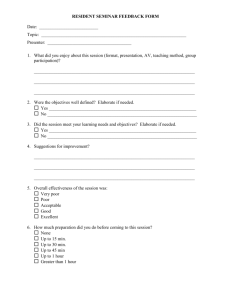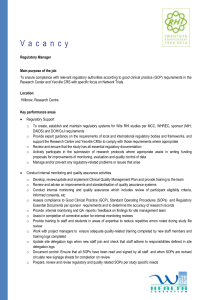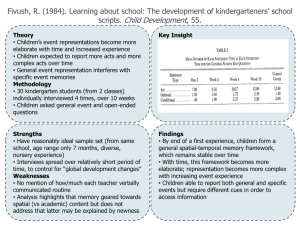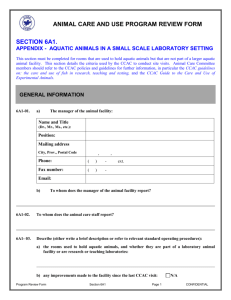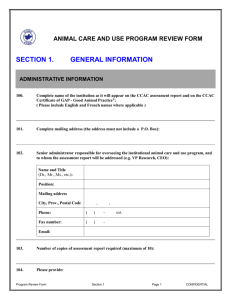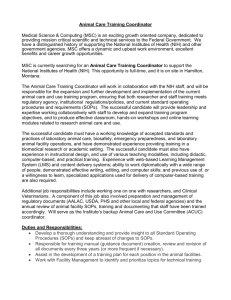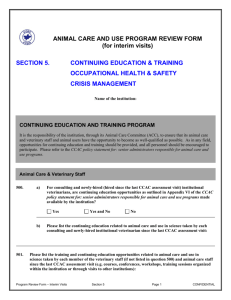ANIMAL CARE AND USE PROGRAM
advertisement
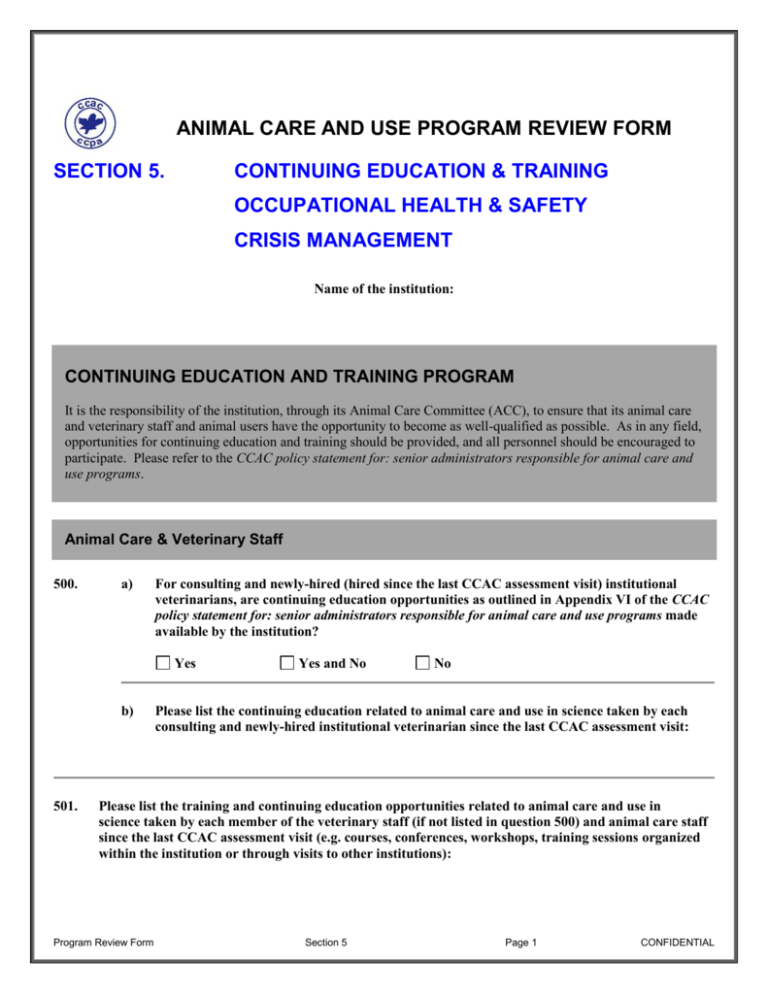
ANIMAL CARE AND USE PROGRAM REVIEW FORM SECTION 5. CONTINUING EDUCATION & TRAINING OCCUPATIONAL HEALTH & SAFETY CRISIS MANAGEMENT Name of the institution: CONTINUING EDUCATION AND TRAINING PROGRAM It is the responsibility of the institution, through its Animal Care Committee (ACC), to ensure that its animal care and veterinary staff and animal users have the opportunity to become as well-qualified as possible. As in any field, opportunities for continuing education and training should be provided, and all personnel should be encouraged to participate. Please refer to the CCAC policy statement for: senior administrators responsible for animal care and use programs. Animal Care & Veterinary Staff 500. a) For consulting and newly-hired (hired since the last CCAC assessment visit) institutional veterinarians, are continuing education opportunities as outlined in Appendix VI of the CCAC policy statement for: senior administrators responsible for animal care and use programs made available by the institution? Yes b) 501. Yes and No No Please list the continuing education related to animal care and use in science taken by each consulting and newly-hired institutional veterinarian since the last CCAC assessment visit: Please list the training and continuing education opportunities related to animal care and use in science taken by each member of the veterinary staff (if not listed in question 500) and animal care staff since the last CCAC assessment visit (e.g. courses, conferences, workshops, training sessions organized within the institution or through visits to other institutions): Program Review Form Section 5 Page 1 CONFIDENTIAL Animal Users Institutions are required to follow the 1999 CCAC guidelines on: institutional animal user training (for senior and junior investigators, study directors, post-doctoral fellows, research staff and graduate students). The CCAC provides information to complement these guidelines, including a complete course for the Core Components of the Recommended Syllabus in a WebCT format, and continues to post available resources, materials and courses on its website (www.ccac.ca). 502. a) Describe what is done to ensure that animal users (including senior and junior investigators, study directors, post-doctoral fellows, research staff and graduate students) are adequately trained to use animals: b) How is the competency of animal users evaluated? c) How is the training of individual users tracked? 503. How do the veterinarian(s) and senior members of the animal care staff contribute to institutional education and training with respect to animal care and use, including teaching of surgical principles and other aspects of experimental animal care and handling? 504. Have any difficulties been encountered in training animal users? Please elaborate. 505. Comments or additional information: OCCUPATIONAL HEALTH AND SAFETY PROGRAM Those working with experimental animals risk exposure to physical hazards (e.g. heat, noise, radiation), chemical hazards (e.g. disinfectants, cleaning solutions), and intestinal parasites, enteric bacteria, pathogenic organisms, and animal bites. All animal care and use, including laboratory and field studies, should be covered by an occupational health and safety program. All persons using the facility should also be familiar with the requirements of relevant federal, provincial and municipal legislation. See Chapter VIII of the CCAC Guide to the Care and Use of Experimental Animals, Volume 1, for further details. Program Review Form Section 5 Page 2 CONFIDENTIAL 506. Does the institution have an occupational health and safety (OHS) program in place with respect to animal use? Yes Yes and No No Please elaborate if your answer is "Yes and No" or "No": 507. 508. a) Who is responsible for its application and how is the implementation of OHS measures monitored? b) How do(es) this or these person(s) work with the ACC to ensure that all animal-based risks are covered? c) How are those who work with or near animals trained to recognize and mitigate risks? Does the occupational health and safety program in place provide adequate measures to protect all individuals working in the animal facilities or who may be exposed to animals? Yes Yes and No No Please elaborate if your answer is "Yes and No" or "No": 509. Comments or additional information: Questions 510 to 526 list components that must be included in an OHS program. Please check the appropriate boxes and provide the table of contents of your OHS program/procedures as Appendix 5B or briefly describe the provisions contained in the institutional OHS program for all those who may have contact with animals. Biological Hazards 510. Are institution-wide SOPs or written measures in place for the use of protective clothing and personal hygiene and cleanliness measures Program Review Form Section 5 Page 3 CONFIDENTIAL handling of pathogens or other biohazardous material according to relevant guidelines N/A 511. Elaborate if SOPs or written measures are not in place for biohazards: 512. Are appropriate facilities and equipment in place for the handling of any pathogens or other biohazardous materials? (summarize or append relevant documentation) Zoonoses (infections transmitted from animals to humans) 513. Are SOPs or written measures in place for appropriate handling of all animals (including any wild animals) by qualified/trained personnel and students reporting and treating bites and scratches control of transmission of disease access to medical assistance as necessary – specify (summarize or append relevant documentation) use of immunizations as appropriate – specify (summarize or append relevant documentation) serological testing special precautions for pregnant individuals 514. Elaborate if SOPs or written measures are not in place for zoonoses: Physical Injuries 515. Are written measures/SOPs in place for identifying particular hazards associated with each species and work area identifying the hazards of individual experiments providing proper working areas, protective clothing and equipment Program Review Form Section 5 Page 4 CONFIDENTIAL use of appropriate restraint devices where necessary N/A reporting and treating physical injuries other than bites and scratches (falls, trauma, etc.) availability of first aid kits protecting those who work in isolated areas 516. Elaborate if SOPs or written measures are not in place for physical injury prevention and treatment: Allergies related to the use of mammals or birds N/A - Go to question 520 517. Are SOPs or written measures in place for use of facility specific clothing and gloves/masks where appropriate availability of facilities for washing hands use of special filtered caging systems for animal transport particularly through public areas N/A training programs for employees and students to avoid developing allergies, particularly in high risk areas and tasks 518. Elaborate if SOPs or written measures are not in place for allergy prevention: 519. Does the facility infrastructure (including ventilation system(s)) help minimize exposure to allergens? Yes Yes and No No Please elaborate (summarize or append relevant documentation): Chemical Injuries N/A - Go to question 523 Program Review Form Section 5 Page 5 CONFIDENTIAL 520. Where any chemicals are used in animal facilities, are there written measures/SOPs in place for training with respect to the Workplace Hazardous Materials Information System (WHMIS) availability of material safety data sheets (MSDS) for all chemicals used handling chemicals and volatile compounds special precautions to be taken for dangerous chemicals used for specific experiments 521. Elaborate if SOPs or written measures are not in place for chemical injury prevention and treatment: Radiation and Ultraviolet Light N/A - Go to question 524 522. Where use is made of radioisotopes, x-rays or UV light, are written measures/SOPs in place for training of personnel/students in appropriate safe work and handling techniques use of appropriate safety equipment and techniques use of dosimeters for work with radioisotopes or x-rays use of "wraparound" safety glasses for UV light 523. N/A N/A Elaborate if SOPs or written measures are not in place for radiation/UV injury prevention and treatment: Procedures for Working with Non-Human Primates N/A - Go to question 526 524. Where non-human primates are used, are written measures/SOPs in place for training of personnel/students in appropriate safe work and handling techniques, and in the risks associated with work with non-human primates, including zoonoses such as Herpes Simiae (B-Virus), hepatitis, Simian Immunodeficiency Virus (SIV), etc. Program Review Form Section 5 Page 6 CONFIDENTIAL protective clothing – specify what is worn for work with non-human primates: procedures for accidents including bites, scratches and/or other exposure to potential risk (summarize or append relevant documentation) access to informed medical assistance - specify: serological screening and vaccinations tuberculosis screening yearly medical follow-ups personal hygiene, availability of facilities for washing hands Elaborate if SOPs or written measures are not in place for work with non-human primates: 525. Does the facility infrastructure and equipment help protect those working with non-human primates? Specify (summarize or append relevant documentation): Conclusion 526. Comments or additional information: CRISIS MANAGEMENT Please refer to section 5d) of the 2006 CCAC policy statement on: terms of reference for animal care committees. Information on crisis management can also be found on the CCAC website. 527. Is a crisis management program in place for the animal care and use program? Yes Yes and No No Please elaborate if your answer is "Yes and No" or "No": 528. Does it include plans in the event of Program Review Form Section 5 Page 7 CONFIDENTIAL Brief power outages Prolonged power outages Work stoppages Fires Natural disasters Large chemical spills and other similar crises Threats to the personnel or facilities from extremists Any other types of crises – please specify: 529. Does it also include a communications plan for addressing public and media inquiries on concerns related to animal use? Yes Yes and No No Please elaborate if your answer is "Yes and No" or "No": 530. Please provide your crisis management documentation, including any relevant SOPs, in appendix 5C. 531. Comments or additional information: APPENDICES Please provide the following appendices and use the checklist to indicate that they have in fact been included. If you are not including one or more of the requested appendices, please briefly explain why for each. Appendix 5A: List of institutional training courses/sessions offered to animal users, if available, along with course outlines. Appendix 5B: Table of contents of the occupational health and safety program. Appendix 5C: A copy of the crisis management program, as it applies to the animal care and use program. Program Review Form Section 5 Page 8 CONFIDENTIAL Additional Appendices (specify): Please explain if you are excluding any of the requested appendices: Program Review Form Section 5 Page 9 CONFIDENTIAL
